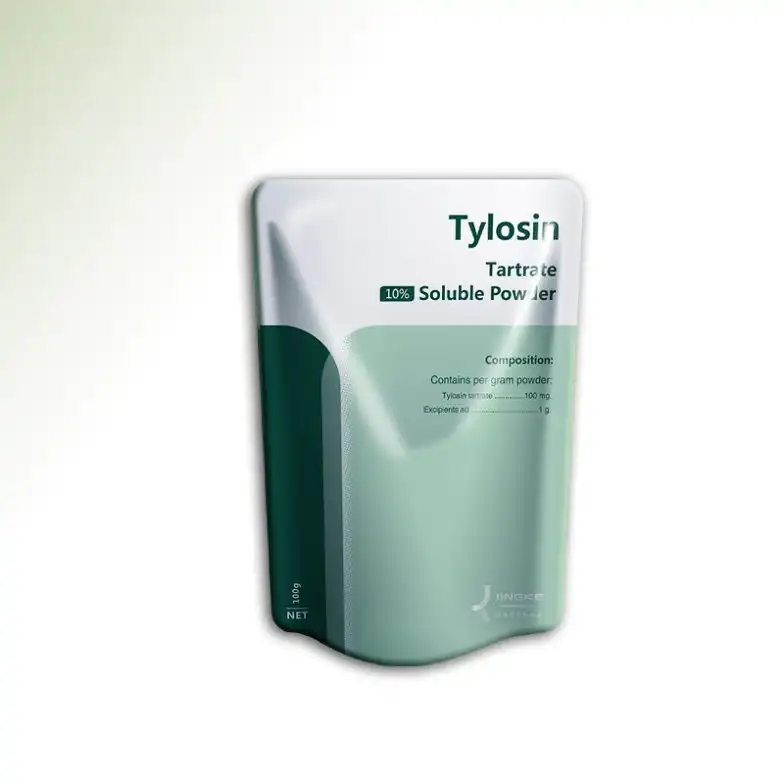Tylosin, also known as Tylan or Tylosin Tartrate, is a macrolide antibiotic first obtained in the United States in 1959 from the culture broth of Streptomyces fradiae.
Tylosin is a white, plate-like crystal, slightly soluble in water, and alkaline. Products include tartrate, phosphate, hydrochloride, sulfate, and lactate salts, which are readily soluble in water. Its aqueous solution can be stored for 3 months at 25°C and pH 5.5-7.5. However, the presence of metal ions such as iron and copper in the aqueous solution will render the product ineffective.
Tylosin is a common veterinary drug for livestock and poultry. Currently, three common forms are available on the market: Tylosin base, sulfate, and tartrate. According to national veterinary drug standards, it comes in three concentrations: 5%, 10%, and 50%. The 10% concentration is the most common in the market and can be used for disease prevention, treatment, and promoting animal growth.

Characteristics of Tylosin Tartrate:
- It is an antibiotic specifically for livestock and poultry, posing no risk of cross-resistance in humans.
- It requires a small dosage and can be added to feed at low doses for long periods, with a significantly better growth-promoting effect than most other antibiotics.
- When added to feed, it is rapidly absorbed orally, generally reaching peak blood concentration within 2-3 hours. It has a wide distribution in tissues, maintains an effective bacteriostatic concentration for a long time, and is thoroughly excreted.
- It is the drug of choice for mycoplasmal diseases in livestock and poultry.
- It has a broad antibacterial spectrum. In addition to being highly effective against mycoplasma, it also has strong activity against Staphylococcus, Streptococcus, Corynebacterium, Mycobacterium, Pasteurella, and Spirochetes. It also has some effect against coccidiosis.
- Tylosin has a good growth-promoting effect. When used rationally as a feed additive, it not only prevents livestock and poultry diseases and ensures their health but also significantly promotes their growth and development, especially in young and growing animals. This can improve feed utilization, shorten the feeding cycle, and increase the economic benefits of breeding.
- Tylosin phosphate has a stable molecular structure, high biological activity, and bioavailability, making it a rising star among antibiotic additives in the feed industry.
Clinical Applications in Veterinary Medicine:
With the continuous increase in the production of domestic tylosin, the application of this antibiotic in veterinary clinics in China has become increasingly common. It is mainly used for the prevention and treatment of the following livestock and poultry diseases:
1. Mycoplasmal Diseases:
The specific efficacy against mycoplasma is a significant feature of tylosin, making it the preferred drug for preventing and treating mycoplasmal diseases in livestock and poultry. It is primarily used to control swine mycoplasmal pneumonia (also known as enzootic pneumonia of pigs or swine enzootic pneumonia, commonly referred to as pig asthma), Mycoplasma gallisepticum infection in chickens (also known as chronic respiratory disease of chickens), contagious caprine pleuropneumonia (also known as goat mycoplasmal pneumonia), bovine mycoplasmal mastitis and arthritis, ovine mycoplasmal agalactia and arthritis, porcine mycoplasmal polyserositis and arthritis, and avian mycoplasmal synovitis.
2. Bacterial Diseases:
Tylosin has good efficacy against diseases caused by various Gram-positive bacteria and also has a good effect on diseases caused by certain Gram-negative bacteria. In veterinary clinical practice, it is mainly used for the prevention and treatment of:
- (1) Various pyogenic diseases caused by Staphylococcus aureus, such as acute and chronic mastitis in cattle and sheep, dermatitis and lamb septicemia in sheep, dermatitis and abortion in pigs, traumatic infections, abscesses, and cellulitis in horses, and gangrenous dermatitis, septicemia, omphalitis, and arthritis in chickens.
- (2) Mastitis in cattle and sheep, swine septicemia, arthritis, meningitis in piglets, strangles, traumatic infections, and cervicitis in mares caused by Streptococcus.
- (3) Suppurative-caseous lymphadenitis (pseudotuberculosis) in sheep caused by Corynebacterium pseudotuberculosis, ulcerative lymphangitis and subcutaneous abscesses in horses caused by Corynebacterium equi, pyelonephritis and mastitis in cattle, urinary tract infections in pigs, and swine clostridial enteritis caused by Clostridium perfringens type C.
- (4) Swine pasteurellosis, bovine hemorrhagic septicemia, fowl cholera, and pasteurellosis in sheep, horses, and rabbits caused by Pasteurella. Swine erysipelas caused by Erysipelothrix rhusiopathiae.
- (5) Various salmonellosis in livestock and poultry caused by Salmonella. Various colibacillosis in livestock and poultry caused by pathogenic Escherichia coli.
- (6) Swine atrophic rhinitis caused by Bordetella bronchiseptica. Tuberculosis in cattle, pigs, and chickens caused by Mycobacterium.
- (7) Abortion and infertility in cattle, sheep, and pigs caused by Brucella. Abortion and infertility in cattle and sheep caused by Campylobacter fetus (formerly known as Vibrio fetus).
- (8) Enteritis in pigs and chickens caused by Campylobacter coli (formerly known as Vibrio coli).
3. Spirochetal Diseases:
Swine dysentery caused by Serpulina hyodysenteriae, avian spirochetosis caused by Borrelia anserina.
4. Anticoccidial Activity:
Adding tylosin to feed can prevent and treat chicken Eimeria coccidiosis.

